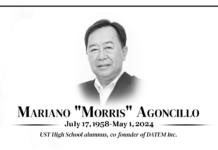 STUDENTS, teachers used to say, are like in a fish bowl. Whatever they do in class—the cheating and all the horsing around, for instance—are not left unnoticed by the man behind the desk.
STUDENTS, teachers used to say, are like in a fish bowl. Whatever they do in class—the cheating and all the horsing around, for instance—are not left unnoticed by the man behind the desk.
But come to think of it, who’s actually under scrutiny in a classroom setup? Especially with the advent of social networking sites generally accessible in class, teachers can easily fall prey to their students’ profiling on any given day. There’s Ma’am Y who dozes off during group reporting. Or Sir X who gives the front row a “sprinkle” or two.
So make no mistake about it: Teachers—much like their students—are in a fish bowl, too, so to speak.
Accounts by upperclassmen add to the profiling. By their descriptions, a professor could be the quintessential disciplinarian who talks tough and carries a big stick, literally.
“It is sometimes a projection of past experiences which triggers one person to label or think of a person a certain way,” Kristine Cadano, guidance counselor of the College of Architecture, explained.
These labels, according to Cadano, are eventually passed on to other students who might easily develop an impression on professors that they will meet for the first time.
Ma. Regina De Leon-Atinaja, guidance counselor of the Faculty of Arts and Letters, said labeling professors could be a result of the students’ lack of responsibility, which probably led to their bad experiences with their teachers.
“Labeling professors, if you will look at it, sometimes come from the shortcomings of the students—their experiences with them,” she said.
Joel Adamos, the College of Education’s chair for education programs, said some students, particularly freshmen, had the tendency to compare their professors’ attitudes and teaching styles.
“You can’t prevent that, especially for first year students who just finished high school. Their teachers were their friends then, unlike in college where the professors prefer a distant relationship with their students,” he said.
Unblocking perception
Adamos noted that professors are individuals with different personalities, which unconsciously reflect their teaching styles.
“They (professors) are different types of persons; students should learn how to deal with them. This will train them (students) to be more competent professionals,” he said.
Cadano said understanding professors’ various personalities could help students learn things which can mold them as responsible, open-minded adults.
“Your professors are willing to assist you to be the best person you can be. Their style [of teaching] just varies,” she pointed out.
She added: “Communication is really the key. It is important for the students to have an open relationship with their professors and an open mind.”
Breaking barriers
Atinaja described a student-professor relationship as a two-way street, and advised students to be responsible and do their part.
“Come to class prepared and always be attentive to what your professors are saying,” she said.
Adamos added that this would not be hard because professors set high standards for students to maintain the quality of education.
The guidance counselor of the Faculty of Arts and Letters also advised students not to let fear stop them from performing well in class.
“This [fear] is the reason why students tend to lose confidence,” she said.
Cadano reminded students that their professors are persons too. “They are there to assist you in achieving your full potential,” Cadano said.
But with this realization at hand, she noted that students should not forget to respect their professors.
“These people, for all you know, may be your future colleagues,” she said. Alma Maria L. Sarmiento













